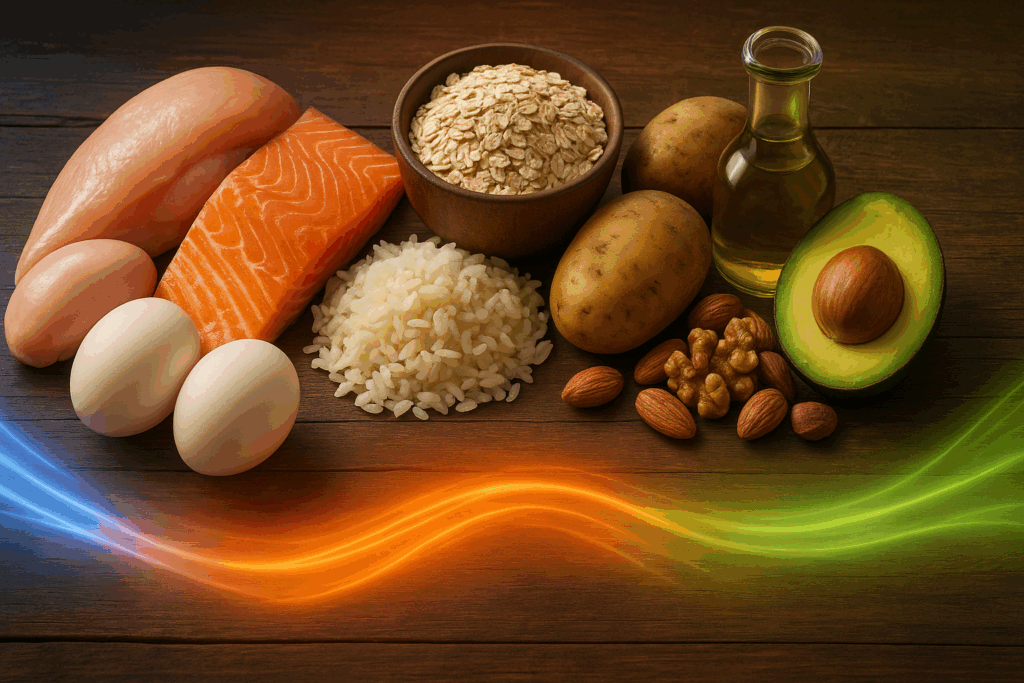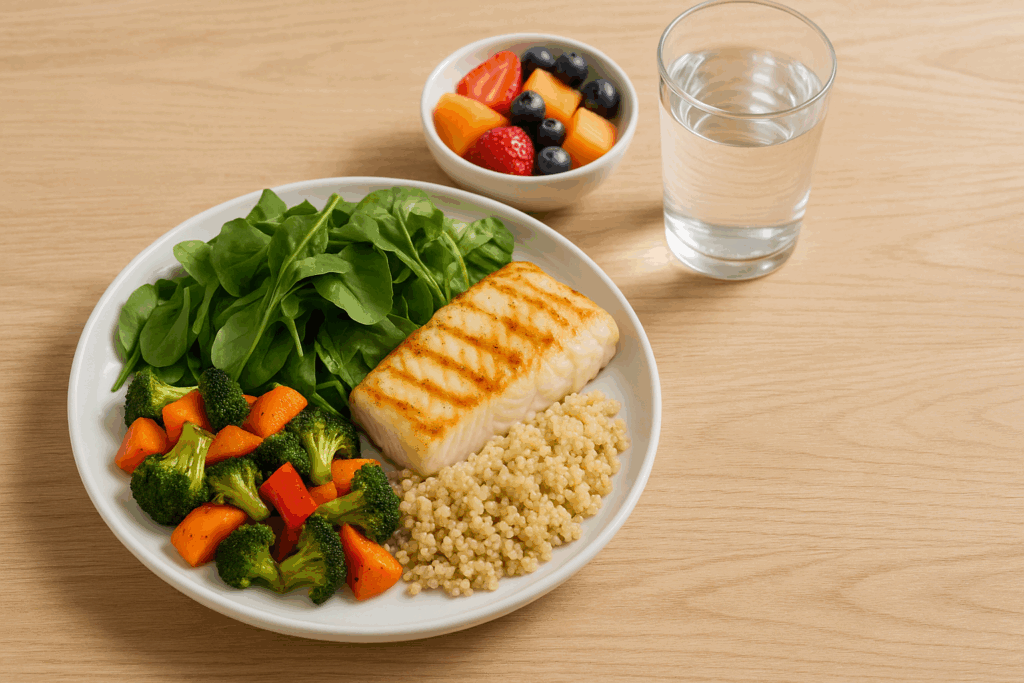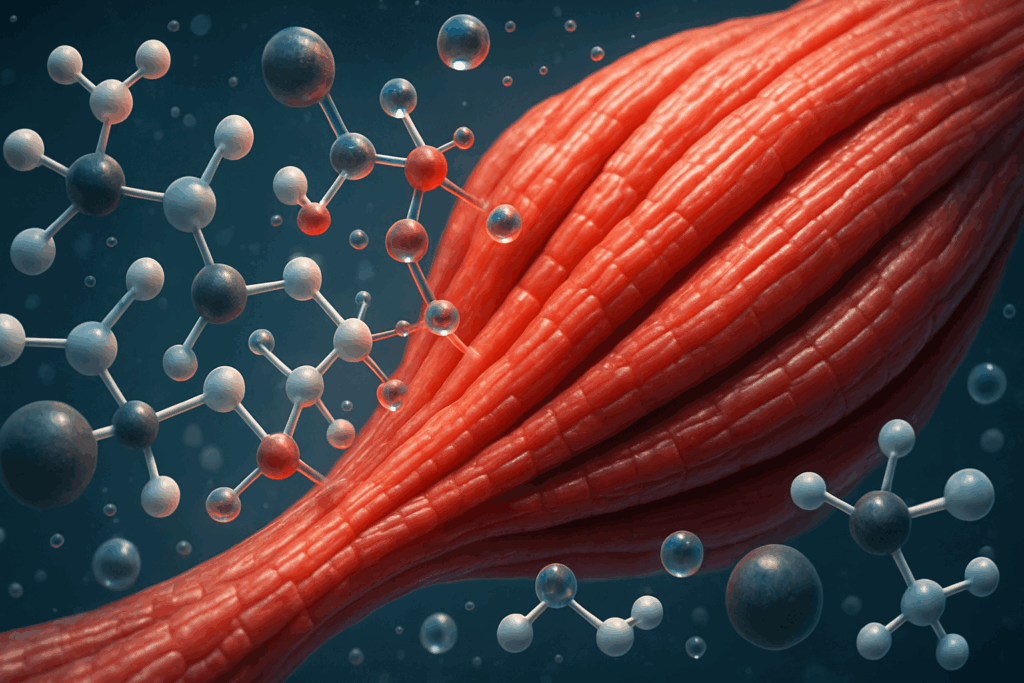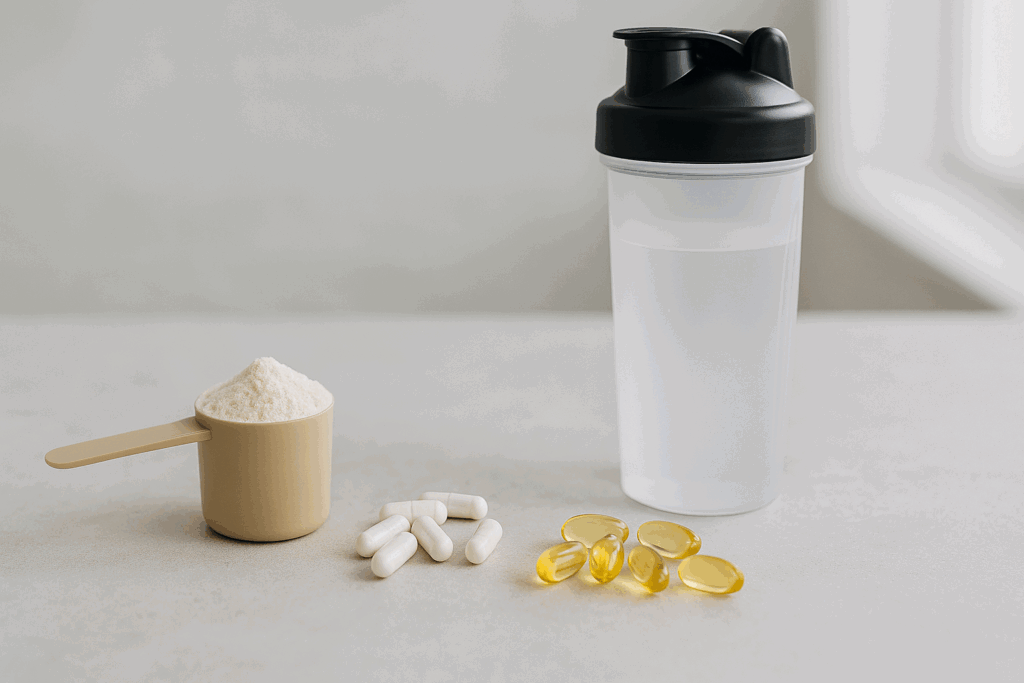Introduction
In the world of performance nutrition for strength, nothing is more critical to sustained progress than understanding the science and strategy behind weightlifting nutrition. Proper fueling isn’t just about calories in and calories out; it’s about selecting the right macronutrients and micronutrients at the right times to maximize strength, optimize recovery, and support hypertrophic gains. For serious lifters, the kitchen is as important as the squat rack, and the fork becomes a tool for transformation. This guide offers an advanced, evidence-based approach to diet and weight training that will elevate both performance and physique.
You may also like: The Ultimate Guide to Building Strength Safely with a Proven Weightlifting Training Program
Understanding the Foundations of Weightlifting Nutrition
To master nutrition for lifting, one must first grasp the interplay between the body’s energy systems, muscle protein synthesis, and hormonal signaling. Unlike general fitness diets, a strength training diet must support neuromuscular adaptations, glycogen replenishment, and tissue repair. Carbohydrates become indispensable for high-volume resistance training sessions due to their role in sustaining ATP production. Proteins, the building blocks of muscle, must be strategically distributed throughout the day to stimulate MPS (muscle protein synthesis), especially around workouts. Fat intake, while often misunderstood, plays a vital role in hormone regulation and cellular health. Each macronutrient, when balanced appropriately, serves a precise purpose in a strength training eating plan that aligns with athletic goals.

Eating for Weight Training: Timing Is Everything
While the average gym-goer may only consider calories, advanced athletes know that nutrient timing can make or break a session. Eating for weight training involves more than just hitting protein targets; it requires manipulating nutrient intake to complement the training window. A meal consumed 60 to 90 minutes before lifting should include moderate protein, low-glycemic carbohydrates, and minimal fat to provide steady energy and amino acid availability. Post-workout nutrition for strength training should focus on rapidly digestible carbohydrates and high-quality protein to initiate recovery. This dual-window strategy enhances glycogen repletion, curbs muscle protein breakdown, and primes the body for adaptation.

Crafting the Optimal Strength Training Diet Plan
Creating a strength training diet plan requires personalization, but the principles remain universal. Start with a caloric baseline that supports your current training load and adjust based on weekly performance feedback. For muscle gain phases, a modest caloric surplus of 250–500 calories per day ensures consistent anabolic signaling. Macronutrient distribution should lean heavily on complex carbohydrates, comprising 45–60% of total intake, followed by protein at 25–35%, and fats at 15–25%. Individual variations exist, especially for those following specialized approaches such as ketogenic or carb-cycling resistance training diets. Regardless of approach, consistent meal planning and nutrient tracking are indispensable for goal alignment.
Integrating Weightlifting Nutrition into Daily Life
The challenge for most lifters is not knowledge but execution. Integrating weightlifting nutrition into a busy life demands organization, habit formation, and smart food choices. Meal prepping is one of the most effective strategies for compliance, especially when aligned with a structured weight training diet program. Prioritize whole, nutrient-dense foods such as lean meats, eggs, oats, sweet potatoes, legumes, nuts, and dark leafy greens. Use supplementation only when dietary gaps are present or for convenience—examples include whey protein, creatine monohydrate, and fish oil. By establishing routines and understanding how to construct balanced meals for working out, athletes can support their strength and recovery needs effortlessly.

What to Eat When Lifting Weights to Lose Weight
Navigating nutrition for lifting during a fat loss phase requires precision. The key is to maintain muscle mass while shedding fat, a goal that depends heavily on maintaining adequate protein intake and managing energy balance. Carbohydrates should be reduced but not eliminated to preserve performance and muscle glycogen stores. Eating for strength training while in a deficit should include nutrient-dense, low-calorie foods that provide satiety and recovery support. Fiber-rich vegetables, lean proteins, and strategic post-workout carbs can fuel sessions while supporting body composition changes. Regular refeed days and cyclic carbohydrate strategies can also prevent metabolic adaptation and maintain training intensity.

Tailoring a Weightlifting Eating Plan for Women
Women face unique hormonal, metabolic, and physiological differences that affect how they should approach a weightlifting eating plan. Unlike men, women often have greater insulin sensitivity during certain phases of the menstrual cycle and higher baseline cortisol levels, which can influence nutrient utilization. A weight training diet for females should account for these factors with adjusted macronutrient ratios, particularly increasing carbohydrates during ovulatory phases and focusing on protein premenstrually. Iron, calcium, and omega-3 intake also deserve special attention due to the higher risk of deficiency. Ultimately, a well-tailored weight lifting diet for women enhances performance while supporting long-term hormonal balance.
Building a Nutrition Plan for Strength Training Success
No strength training diet plan is complete without periodization. Just as training cycles include phases of hypertrophy, strength, and deload, so too should a nutrition plan for strength training evolve. During deload weeks, reduce caloric intake slightly to match lower activity levels. In contrast, peaking phases may require increased carbohydrate consumption to support maximal output. Regular assessments, such as body composition analysis, performance metrics, and subjective energy levels, should inform adjustments. This dynamic approach ensures the body receives the fuel it needs without stagnation or overreach, supporting continued gains and resilience.

Resistance Training Diet Strategies That Work
There is no one-size-fits-all resistance training diet, but successful strategies often include a few common themes. First, prioritize consistency over complexity. Second, use intra-workout carbohydrates and electrolytes for long, high-volume sessions. Third, practice meal diversity to avoid nutrient monotony and micronutrient deficiencies. Athletes who adapt these strategies into their weight training eating plans tend to experience better recovery, fewer injuries, and sustainable performance growth. Tracking tools, whether digital apps or journals, can enhance awareness and accountability, leading to more precise execution.
The Science Behind Weightlifting Nutrition for Hypertrophy
Hypertrophy—the enlargement of muscle fibers—depends heavily on both mechanical tension and the availability of recovery substrates. Weightlifting nutrition, therefore, must emphasize not just macronutrients but also micronutrients involved in tissue regeneration, such as zinc, magnesium, and B-vitamins. Protein quality matters immensely, with leucine-rich sources (like whey, eggs, and lean meats) being most effective at triggering the mTOR pathway. Frequent protein feedings (every 3 to 4 hours) amplify MPS and help maintain a positive nitrogen balance. Adequate sleep, hydration, and anti-inflammatory foods further support the anabolic environment required for muscle growth.

Diet and Weight Training for Athletic Performance
While hypertrophy is a common goal, many lifters prioritize performance over aesthetics. Diet and weight training for performance require higher attention to fuel timing, electrolyte balance, and digestive health. Athletes must ensure they are not just eating enough, but that their digestion and absorption are optimal. Fermented foods, digestive enzymes, and attention to food intolerances can improve nutrient assimilation. During competition phases, micronutrient supplementation and precise pre-lift fueling protocols become crucial. This is where a highly individualized weight training diet program sets elite athletes apart from recreational lifters.
Recovery-Focused Meals for Working Out
Recovery is often misunderstood as passive rest, but it is an active biological process that can be accelerated through intelligent nutrition. Meals for working out should always prioritize post-exercise recovery with protein and carbohydrate combinations that restore glycogen and repair tissue. Chocolate milk, salmon with quinoa, or Greek yogurt with berries are all examples of powerful recovery meals. Inflammatory markers such as CRP and cortisol can be reduced through omega-3s, polyphenols, and antioxidants, making food a pharmacological ally in muscle repair. Timing, macronutrient composition, and food quality all influence recovery speed and effectiveness.
Nutrition for Strength Training Through the Lifespan
As lifters age, their metabolism, hormonal profile, and recovery capacity change. Nutrition for strength training must evolve accordingly. Older lifters benefit from increased protein intake due to anabolic resistance, as well as targeted supplementation with creatine, vitamin D, and joint-supporting nutrients like collagen and curcumin. Timing becomes even more critical, with peri-workout nutrition taking precedence to combat slower recovery rates. Bone density, joint health, and lean mass preservation become top priorities. A strength training eating plan for aging athletes must balance ambition with injury prevention and systemic health maintenance.
Creating a Sustainable Weight Training Diet Program
The sustainability of a weight training diet program is just as important as its efficacy. Dietary fatigue, social pressures, and rigid meal structures often lead to dropout or rebound weight gain. To create lasting change, lifters must integrate flexibility, intuitive eating elements, and cultural food preferences into their plans. Flexible dieting, also known as If It Fits Your Macros (IIFYM), can provide structure without rigidity. Strategies like batch cooking, scheduled indulgences, and mindful eating practices enhance sustainability while maintaining performance. The goal is to turn a strength-focused eating plan into a lifelong nutritional philosophy, not just a temporary protocol.
Crafting the Ultimate Strength Training Eating Plan for Competition Prep
Preparing for competition, whether powerlifting, Olympic lifting, or bodybuilding, places unique stress on the body. A strength training eating plan for competition must integrate calorie tapering, water manipulation, and glycogen supercompensation. Cutting phases should preserve muscle while meeting weight class targets, often through calculated carb and sodium reduction. Peak week protocols might involve carb-loading, sodium cycling, and meal timing to optimize vascularity and strength. Psychological readiness, sleep, and digestive ease also play pivotal roles during this phase. Planning ahead and testing prep strategies weeks in advance ensures peak condition on competition day.
The Role of Supplementation in Weightlifting Nutrition
Though food should form the foundation, targeted supplementation can enhance a well-structured weightlifting eating plan. Creatine monohydrate improves strength, power output, and muscle hydration. Beta-alanine buffers fatigue during high-rep sets. Whey protein ensures rapid amino acid delivery post-workout. Multivitamins and mineral support can address gaps common in restrictive or plant-based diets. Pre-workout formulas and adaptogens like ashwagandha or Rhodiola rosea may help with focus and stress adaptation. However, supplementation should be used as an adjunct, not a crutch. Quality, dosage, and timing matter—always choose third-party tested products.

Training and Diet: Finding the Synergy for Growth
The most effective athletes are those who align their training and diet in a harmonious loop. Training volume, intensity, and recovery dictate nutritional needs, while dietary intake influences energy availability and adaptation. Tracking systems such as RPE (Rate of Perceived Exertion), HRV (Heart Rate Variability), and food journals provide feedback for adjustments. Understanding this synergy empowers lifters to push when needed, rest when required, and adapt in real time. A dynamic relationship between training and diet cultivates both physical growth and mental resilience, ensuring longevity in strength sports.
Frequently Asked Questions: Advanced Perspectives on Weightlifting Nutrition
1. What role does nutrient timing play in weightlifting nutrition and performance optimization?
Nutrient timing is a nuanced component of weightlifting nutrition that extends beyond the classic pre- and post-workout meal concepts. Consuming carbohydrates and protein in the hours leading up to resistance training can increase glycogen availability, improving energy output and endurance. Intra-workout nutrition, particularly branched-chain amino acids (BCAAs) and fast-digesting carbs, helps preserve muscle mass during long or high-volume sessions. Post-training, prioritizing a blend of protein and simple carbohydrates initiates muscle repair and replenishment of depleted glycogen stores. This strategic meal timing not only improves strength training diet outcomes but also shortens recovery periods, allowing lifters to train more effectively and frequently.
2. How do stress and sleep quality impact your strength training eating plan?
Chronic stress and poor sleep quality are two silent saboteurs of any strength training eating plan. Elevated cortisol levels from stress impair protein synthesis and increase muscle breakdown, diminishing gains even with an ideal nutrition plan for strength training. Similarly, insufficient or fragmented sleep reduces testosterone and growth hormone levels, both critical for muscle repair. Incorporating sleep-supportive foods—like magnesium-rich leafy greens or tryptophan-containing turkey—can subtly reinforce hormonal recovery. Holistically aligning your training and diet plan with a consistent sleep schedule significantly enhances results from your weight training diet program.
3. Can a weight training diet for women differ significantly from male-centric programs?
Yes, tailoring a weight training diet for women involves recognizing hormonal, metabolic, and physiological differences. Women often require higher iron and calcium intakes, especially when training intensely. Additionally, because estrogen supports better fat metabolism and insulin sensitivity, women may benefit from more moderate carbohydrate cycling strategies compared to men. Timing carbohydrate intake around ovulation, when energy levels and performance capacity tend to be highest, can optimize training intensity. Personalizing a weight lifting diet for women empowers female athletes to capitalize on their unique physiology while pursuing muscle and strength gains.
4. What innovations are emerging in diet for working out protocols?
The field of diet for working out is evolving through biotechnology, precision nutrition, and gut microbiome research. Personalized meal recommendations based on continuous glucose monitoring can reveal how individual bodies respond to specific pre-workout foods. Furthermore, advances in gut microbiota analysis show how probiotic-rich diets can enhance amino acid absorption and recovery in strength athletes. Emerging trends like ketogenic cycling or plant-based high-protein protocols also offer alternative paths to achieving success with weight training eating plans. These innovations reflect a move away from one-size-fits-all advice and toward truly individualized nutrition for lifting outcomes.
5. How does psychological state affect adherence to a strength training diet plan?
The psychological dimension of maintaining a strength training diet plan is often overlooked. Emotional stress can trigger cravings for high-sugar foods that derail a structured nutrition plan for working out. Incorporating mindful eating practices—such as slowing down meals and recognizing hunger cues—can significantly reduce overeating. Additionally, self-identity plays a key role; individuals who view themselves as “athletes” tend to make more consistent choices aligned with a resistance training diet. Understanding the mental-emotional connection in weightlifting nutrition enhances both adherence and long-term progress.
6. What are smart strategies for applying weightlifting nutrition during injury recovery?
When recovering from injury, weightlifting nutrition shifts its purpose from performance enhancement to tissue repair. Increasing intake of collagen-rich foods, omega-3 fatty acids, and antioxidant-rich vegetables can reduce inflammation and accelerate healing. Protein requirements also rise, as muscle atrophy is a risk during periods of reduced activity. While calorie intake may decrease slightly to match lowered energy expenditure, maintaining a nutrient-dense diet for strength helps preserve lean mass. Tailoring your nutrition plan for strength training recovery bridges the gap between inactivity and a full return to lifting.
7. How should meals for working out change during a fat loss phase?
In a fat loss phase, meals for working out must strike a delicate balance between maintaining performance and achieving a caloric deficit. This includes front-loading carbohydrates around training sessions to preserve strength output while tapering them during sedentary hours. High-fiber vegetables and lean proteins should dominate meals to increase satiety without excessive caloric intake. Additionally, timing smaller meals more frequently throughout the day helps maintain energy and manage hunger, making it easier to stick to a weight training diet program. These small adjustments ensure that the strength-focused athlete continues progressing even during weight-reduction phases.
8. How can vegans create an effective resistance training diet?
A plant-based resistance training diet can be highly effective with strategic planning. Combining complementary proteins—such as legumes and grains—ensures all essential amino acids are covered. Nutrient-dense additions like chia seeds, tofu, lentils, and fortified nutritional yeast provide ample protein and iron. Supplementing with B12, vitamin D, and possibly creatine is also recommended for vegans committed to a strength training eating plan. With the right variety and supplementation, eating for strength training on a vegan regimen can yield impressive strength and hypertrophy outcomes.
9. What to eat when lifting weights to lose weight without sacrificing strength?
To lose fat while lifting weights, it’s crucial to prioritize nutrient density over caloric density. Meals should include lean proteins like fish or egg whites, moderate complex carbs such as quinoa or sweet potatoes, and healthy fats from sources like avocado and olive oil. Carbohydrate timing—especially pre- and post-lifting—helps fuel workouts and sustain muscle even in a calorie deficit. Regular hydration and inclusion of fiber-rich vegetables improve metabolism and support digestion, both of which are essential when eating for weight training and fat loss. A well-rounded weightlifting eating plan ensures that performance stays high while fat mass declines gradually.
10. Why is long-term planning crucial for successful diet and weight training results?
The synergy between diet and weight training thrives on consistency and long-term vision. Periodizing your strength training diet across phases—like bulking, maintenance, and cutting—ensures continuous adaptation and progress. Incorporating seasonal changes, social events, or travel into your nutrition plan for working out prevents burnout and promotes sustainability. Developing a flexible mindset that embraces adjustment rather than perfection leads to greater long-term compliance. Ultimately, weightlifting nutrition success depends not just on daily discipline, but on the ability to strategize over months and years of progressive training.
Conclusion: Mastering Weightlifting Nutrition for Long-Term Strength Gains
The journey of strength is not merely a physical endeavor but a metabolic and nutritional one. Mastering weightlifting nutrition means understanding not only what to eat, but when, why, and how it affects performance, recovery, and growth. It calls for a deeper engagement with one’s body, listening to biofeedback, and adjusting based on experience and evolving goals. Whether you are in a bulking phase, cutting for a meet, or simply striving for sustainable strength, the strategic use of food can be your most powerful ally. By aligning your strength goals with an intelligently crafted diet while weight training, you don’t just eat to train—you eat to thrive. Let your next PR begin at the plate.
Further Reading:
Strength on a Plate: The Weight Lifting Diet Guide
Eat This, Lift That! The Beginners Guide To Nutrition For Weight Lifting





